Easy Way to Calculate P Value Using Excel 2016
The p-value is used in correlation and regression analysis in Excel, which helps us identify whether the result is feasible and which data set from the result to work with. The value of the p-value ranges from 0 to 1. Unfortunately, Excel has no built-in method to find out the p-value of a given data set. So instead, we use other functions, such as the Chi-Squared test function.
Excel P-Value
The p-value is the probability value expressed in percentage value in hypothesis testing Hypothesis Testing is the statistical tool that helps measure the probability of the correctness of the hypothesis result derived after performing the hypothesis on the sample data. It confirms whether the primary hypothesis results derived were correct. read more to support or reject the null hypothesis. The p-value or probability value is a popular concept in the statistical world. Aspiring analysts should know about the p-value and its purpose in data science. For example, a frequency of the data points is called the hypothetical frequency and observed significance level for the test hypothesis.
- Decimal points denote p-value, but it is always good to tell the result of the p-value in percentage instead of decimal points. For example, telling 5% is always better than telling the decimal point 0.05.
- In the test conducted to find the p-value, if the p-value is smaller, the stronger evidence against the null hypothesis and your data is more significant. Conversely, if the p-value is higher, there is weak evidence against the null hypothesis. So, by running a hypothesis test and finding the p-value, we can understand the significance of the finding.
Table of contents
- Excel P-Value
- How to Calculate the P-Value in T-Test in Excel?
- P-Value Excel T-Test Example #1
- P-Value Excel Example #2 – Find P-Value with T.TEST Function
- Things to Remember
- Recommended Articles
- How to Calculate the P-Value in T-Test in Excel?

You are free to use this image on your website, templates, etc, Please provide us with an attribution link Article Link to be Hyperlinked
For eg:
Source: P-Value in Excel (wallstreetmojo.com)
How to Calculate the P-Value in T-Test in Excel?
Below are examples of Calculating P-Value P-Value, or Probability Value, is the deciding factor on the null hypothesis for the probability of an assumed result to be true, being accepted or rejected, & acceptance of an alternative result in case of the assumed results rejection. read more in the Excel T-Test.
You can download this P-Value Excel Template here – P-Value Excel Template
P-Value Excel T-Test Example #1
In Excel, we can find the p-value easily. By running the T-Test in excel A T-test in excel helps compare the means (average) of two samples and make inferences for the entire populations. read more , we can determine whether the null hypothesis is TRUE or FALSE. Look at the below example to understand the concept practically.
Assume you are supplied with the weight loss process through diet data. Below is the data available to you to test the null hypothesis.
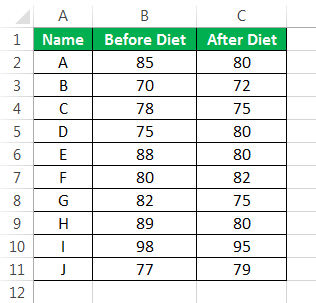
- First, we need to calculate the difference between before and after diet.
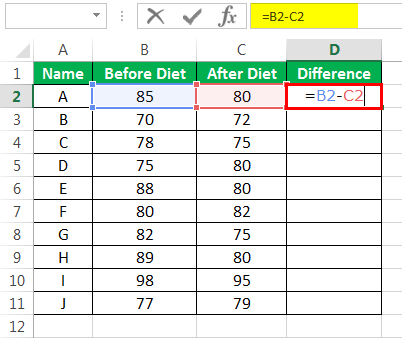
The output is given below:

Drag the Formula to the rest of the cells.

- Now, go to the "Data" tab, and click on "Data Analysis" under the "Data" tab.

- Now, scroll down and find the "T.Test: Paired Two Sample for Means."
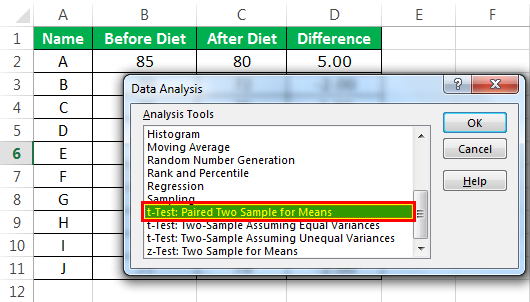
- Now, we must select "Variable 1 Range" as before the diet column.
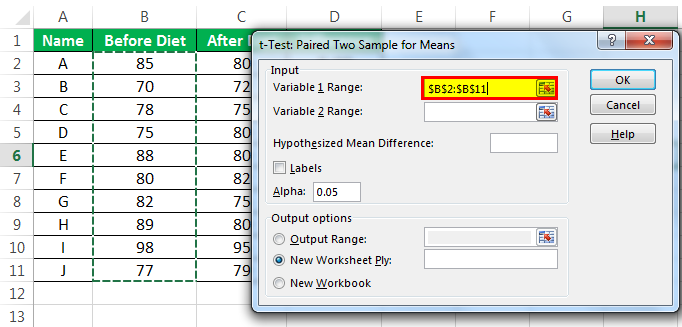
- Select "Variable 2 Range" after a diet column.

- The alpha value will be default 0.05, 5% for retaining the same value.
Note: 0.05 and 0.01 are often used as common levels of significance.

- Select the "Output Range" where we want to display the analysis results.
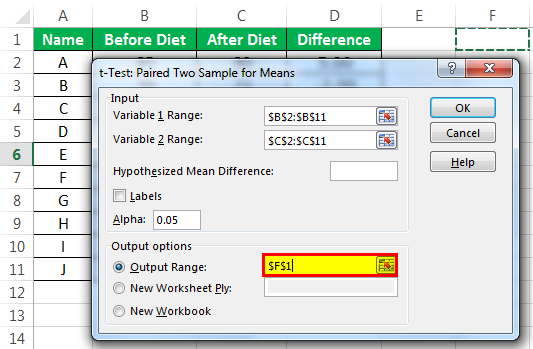
- Click on the "OK." We have analysis results from cell F1.
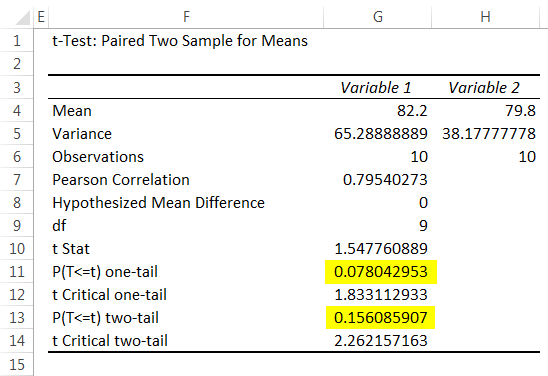
We have results here. The p-value with a one-tail test is 0.078043, and the p-value with the two-tail test is 0.156086. In both cases, the p-value is greater than the alpha value, 0.05.
In this case, the p-value is greater than the alpha value, so the null hypothesis is TRUE, i.e., weak evidence against the null hypothesis. It means it is a very close data point between two data points.
P-Value Excel Example #2 – Find P-Value with T.TEST Function
In Excel, we have a built-in function called T.TEST, which can instantly give us the p-value result.
Open the T.TEST function in any of the cells in the spreadsheet.
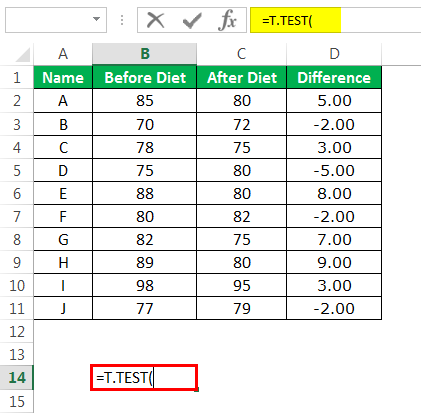
Select array 1 as before the diet column.

The second argument will be after the diet column, array 2.
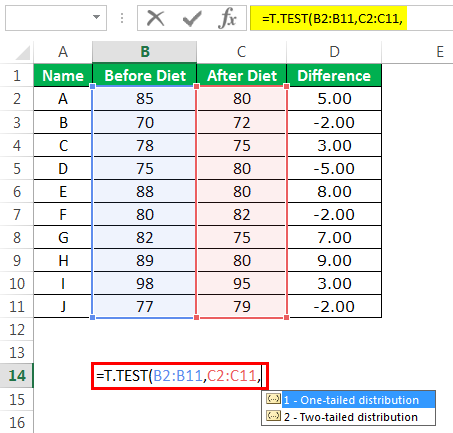
Tails will be one-tailed distribution.

The type will be Paired.

Now, close the formula, and we will have a result of the p-value.

So, we have a p-value of 0.078043, which is the same as the previous test of the analysis result.
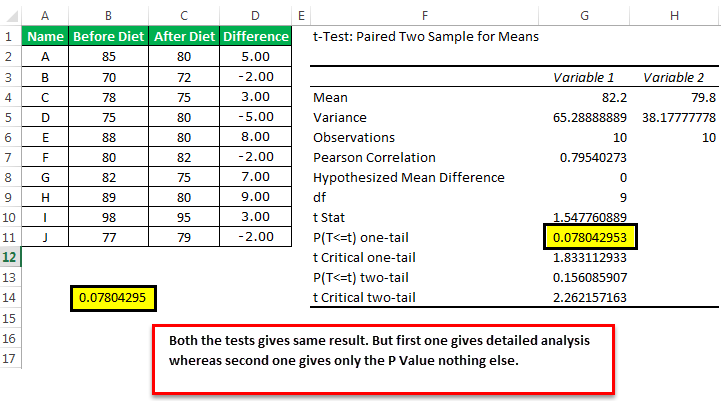
Things to Remember
- We can change the significance level (alpha value) at different levels and arrive at the p-values in Excel at various points.
- The common alpha values are 0.05 and 0.01.
- If the p-value is >0.10, then the data is not significant. If the p-value is <=0.10, then the data is marginally effective.
- If the p-value is <=0.05, then the data is significant, and if the p-value is <0.05, then the data is highly important.
Recommended Articles
This article is a guide to P-Value in Excel. We discuss calculating p-value in Excel T-Test, practical examples, and a downloadable Excel template. You may also learn more about Excel from the following articles: –
- POISSON.DIST Function with Examples Poisson Distribution is a type of distribution which is used to calculate the frequency of events which are going to occur at any fixed time but the events are independent, in excel 2007 or earlier we had an inbuilt function to calculate the Poisson distribution, for versions above 2007 the function is replaced by Poisson.DIst function. read more
- Lognormal Distribution Excel Lognormal Distribution finds out the distribution of a variable whose logarithm is normally distributed. Excel has an inbuilt function to calculate the lognormal distribution. read more
- Standard Deviation Graph Excel The standard deviation is a metric that calculates how values change when compared to or in relation to the mean or average value. Both deviations are represented in a standard deviation graph, with one being positive on the right and the other being negative on the left. read more
- Standard Deviation in Excel
Source: https://www.wallstreetmojo.com/p-value-in-excel/
0 Response to "Easy Way to Calculate P Value Using Excel 2016"
Post a Comment